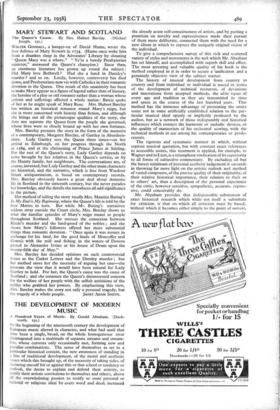MARY STEWART AND SCOTLAND
The Queen's Cause. By Mrs. Hubert Barclay. (Michael Joseph. 15s.)
WALTER GOODALL, a hanger-on of David Hume, wrote the first defence of Mary Stewart in 1754. (Hume once woke him from a drunken sleep in the Advocates' Library by shouting " Queen Mary was a whore." " Ye're a bawdy Presbyterian minister," answered the Queen's champion.) Since then, an enormous literature has grown up round the subject ; Did Mary love Bothwell ? Had she a hand in Darnley's murder ? and so on. Lately, however, controversy has died down, and Presbyterians now vie with Catholics in their romantic devotion to the Queen. One result of this unanimity has been to make Mary appear as a figure of legend rather than of history, the heroine of a play or old romance rather than a woman whose actions and sufferings affected a whole nation: Barrie spoke of her as he might speak of Mary Rose. Mrs. Hubert Barclay has written an historical romance round Mary's reign, but she is more concerned with history than fiction, and although she brings out all the picturesque qualities of the story, she does not separate the Queen from the people she governed, whose lives were so closely bound up with her own fortunes.
Mrs. Barclay presents the story in the form of the memoirs of a contemporary, Margaret Barclay, of Gartley in Aberdeen- shire. Lady Gartley sees the Queen three times—on her arrival in Edinburgh, on her progress through the North in 1564, and at the christening of Prince James at Stirling. For the rest of the Queen's story, Lady Gartley depends on news brought by her relatives in the Queen's service, or by the Huntly family, her neighbours. The conversations are, of course, invented, but Lady Gartley and the other main characters are historical, and the narrative, which is free from Wardour Street antiquarianism, is based on contemporary records. Mrs. Barclay obviously knows a great deal about domestic life in Scotland in the sixteenth century, but she never parades her knowledge, and the details she introduces all add significance to the picture.
Her method of telling the story recalls Mrs. Maurice Baring's In My End is My Beginning, where the Queen's life is told by the four Maries in turn. But while Mr. Baring's narratives seldom stray outside the Court circle, Mrs. Barclay shows us what the familiar episodes of Mary's reign meant to people throughout Scotland. She stresses the connexion between Rizzio's murder and the land-greed of the nobles ; and she shows how Mary's followers offered her more substantial things than romantic devotion. " Once again it was money in exchange for his land, for the good lands of Moncoffer and Gownit with the mill and fishing in the waters of Dovern passed to Alexander Irvine at his house of Drum upon the twenty-fifth day of May."
Mrs. Barclay has decided opinions on such controversial issues as the Casket Letters and the Darnley murder ; but her method saves her the necessity of arguing her case—she presents the view that it would have been natural for Lady Gartley to hold. For her, the Queen's cause was the cause of Scotland ; and she contrasts the Queen's disinterested concern for the welfare of her people with the selfish ambitions of the nobles who grabbed her powers. By emphasising this view, Mrs. Barclay makes the story not only a personal tragedy, but






































 Previous page
Previous page